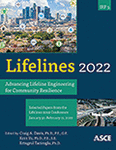Variations in Ground Motion Amplification in the Los Angeles Basin due to the 2019 M7.1 Ridgecrest Earthquake: Implications for the Long-Period Response of Infrastructure
Publication: Lifelines 2022
ABSTRACT
Coherent patterns and large variations in ground shaking amplification were observed in the Los Angeles basin during the 2019 M7.1 Ridgecrest earthquake. In particular, 3 s to 6 s responses showed variations due to shallow basin geological structure that have implications for the response to large earthquakes of mid-rises, high-rises, long-span bridges, and fuel storage tanks, even if epicentral distances are several hundred kilometers. The Ridgecrest strong-motion data were recorded by seismic stations from the spatially dense Community Seismic Network, the Southern California Seismic Network, and the California Strong Motion Instrumentation Program. The mainshock observations are compared at the same locations with ground motion simulations to examine the regions that experienced the largest shaking, and to investigate the geological sources of large-amplitude shaking. The simulations were computed for the two most commonly used regional community seismic velocity models, CVM-S4.26.M01 (‘CVM-S’) and CVM-H 15.1.0 (‘CVM-H’). Both observations and simulations are used in dynamic analysis with a finite-element model of an existing high-rise with 6-s fundamental horizontal periods, located in downtown Los Angeles. The geographical variation in maximum story drift, story-level shear force, and story-level moment values suggest that the excitation of a hypothetical high-rise located in an area characterized by the largest 6-s PSA values could be significantly larger than in a downtown Los Angeles location. Ground motion simulations using the CVM-H velocity model more closely predict the long-period site amplifications in greater Los Angeles, particularly in the south-central San Fernando Valley, than simulations using CVM-S.
Get full access to this article
View all available purchase options and get full access to this chapter.
REFERENCES
ETABS. Structural and Earthquake Engineering Software, Computers and Structures, Inc., Berkeley, CA, www.csi.berkeley.com, 1995. http://docs.csiamerica.com/manuals/etabs/Analysis%20Reference.pdf.
Filippitzis, F., Kohler, M. D., Heaton, T. H., Graves, R. W., Clayton, R. W., Guy, R. G., Bunn, J. J., and Chandy, K. M. (2021). “Ground motions in urban Los Angeles from the 2019 Ridgecrest earthquake sequence.” Earthquake Spectra, early version available online. https://doi.org/10.1177/87552930211003916.
Graves, R. W. (1996). “Simulating seismic wave propagation in 3D elastic media using staggered-grid finite differences.” Bull. Seis. Soc. Am., 86(4), pp.1091–1106.
Graves, R. W., and Pitarka, A. (2016). “Kinematic ground‐motion simulations on rough faults including effects of 3D stochastic velocity perturbations.” Bull. Seis. Soc. Am., 106(5), 2136–2153.
Graves, R. W., and Pitarka, A. (2020). “3D Ground Motion Simulations for Events in the 2019 Ridgecrest Sequence.” 17th World Conference on Earthquake Engineering, 17WCEE, Sendai, Japan - September 13-18, 2020.
Grazier, V., Shakal, A., Scrivner, C., Hauksson, E., Polet, J., and Jones, L. (2002). “TriNet strong-motion data from the M 7.1 Hector Mine, California Earthquake of 16 October 1999, Bull Seis. Soc. Am., 92(4), 1525–1542.
Hatayama, K., and Kalkan, E. (2011). “Long‐period (3 to 10 s) ground motions in and around the Los Angeles basin during the M 7.2 El Mayor-Cucapah Earthquake of April 4, 2010.” Proc. of the 4th IASPEI/IAEE International Symposium, 23–26.
Kohler, M. D., Filippitzis, F., Heaton, T. H., Clayton, R. W., Guy, R. G., Bunn, J. J., and Chandy, K. M. (2020). “2019 Ridgecrest earthquake reveals areas of Los Angeles that amplify shaking of high-rises.” Seis. Res. Lett., 91(6), 3370–3380, doi:https://doi.org/10.1785/0220200170.
Kohler, M. D., Massari, A., Heaton, T. H., Kanamori, H., Hauksson, E., Guy, R., Clayton, R. W., Bunn, J., and Chandy, K. M. (2016). “Downtown Los Angeles 52-story high-rise and free-field response to an oil refinery explosion.” Earthquake Spectra, 32(3), 1793–1820. doi:https://doi.org/10.1193/062315EQS101M.
Lee, E. J., et al. (2014). “Full‐3‐D tomography for crustal structure in southern California based on the scattering‐integral and the adjoint‐wavefield methods.” J. Geophys. Res., 119(8), 6421–6451.
Los Angeles Times. (2020). “L.A. signs off on $1-billion ‘mini-city’ in the west San Fernando Valley.” by David Zahniser, December 2, 2020. https://www.latimes.com/california/story/2020-12-02/l-a-san-fernando-valley-warner-center-mini-city.
Ponti, D., and Martin, P. P. (2021). “Development of a chronostratigraphic hydrogeologic framework model.” In Development of a groundwater-simulation model in the Los Angeles Coastal Plain, Los Angeles County, California. S. R. Paulinski (ed.). U.S.G.S. Scientific Investigations Report 2021-XXXX, X p., https://doi.org/10.31333/sir2021xxxx (in press).
Shaw, J., Plesch, A., Tape, C., Suess, M. P., Jordan, T. H., Ely, G., Hauksson, E., Tromp, J., Tanimoto, T., Graves, R., Olsen, K., Nicholson, C., Maechling, P. J., Rivero, C., Lovely, P., Brankman, C. M., and Munster, J. (2015). “Unified Structural Representation of the southern California crust and upper mantle.” Earth Plan. Sci. Lett., 415, 1–15, doi:https://doi.org/10.1016/j.epsl.2015.01.016.
Taranath, B. S. (1997). Steel, Concrete, and Composite Design of Tall Buildings. 2nd edition, McGraw-Hill, San Francisco.
Thompson, E. (2018). An updated Vs30 map for California with geologic and topographic constraints., doi:https://doi.org/10.5066/F7JQ108S.
Wald, D., and Graves, R. (1998). “The seismic response of the Los Angeles basin, California.” Bull. Seis. Soc. Am., 88(2), 337–356.
Wills, C. J., Gutierrez, C. I., Perez, F. G., and Branum, D. M. (2015). “A Next Generation V S 30 Map for California Based on Geology and Topography.” Bull. Seis. Soc. Am., 105(6), 3083–3091, doi:https://doi.org/10.1785/0120150105.
Information & Authors
Information
Published In
History
Published online: Nov 16, 2022
Authors
Metrics & Citations
Metrics
Citations
Download citation
If you have the appropriate software installed, you can download article citation data to the citation manager of your choice. Simply select your manager software from the list below and click Download.
